tow RENAULT CLIO 2012 X85 / 3.G Owner's Manual
[x] Cancel search | Manufacturer: RENAULT, Model Year: 2012, Model line: CLIO, Model: RENAULT CLIO 2012 X85 / 3.GPages: 268, PDF Size: 8.73 MB
Page 195 of 268
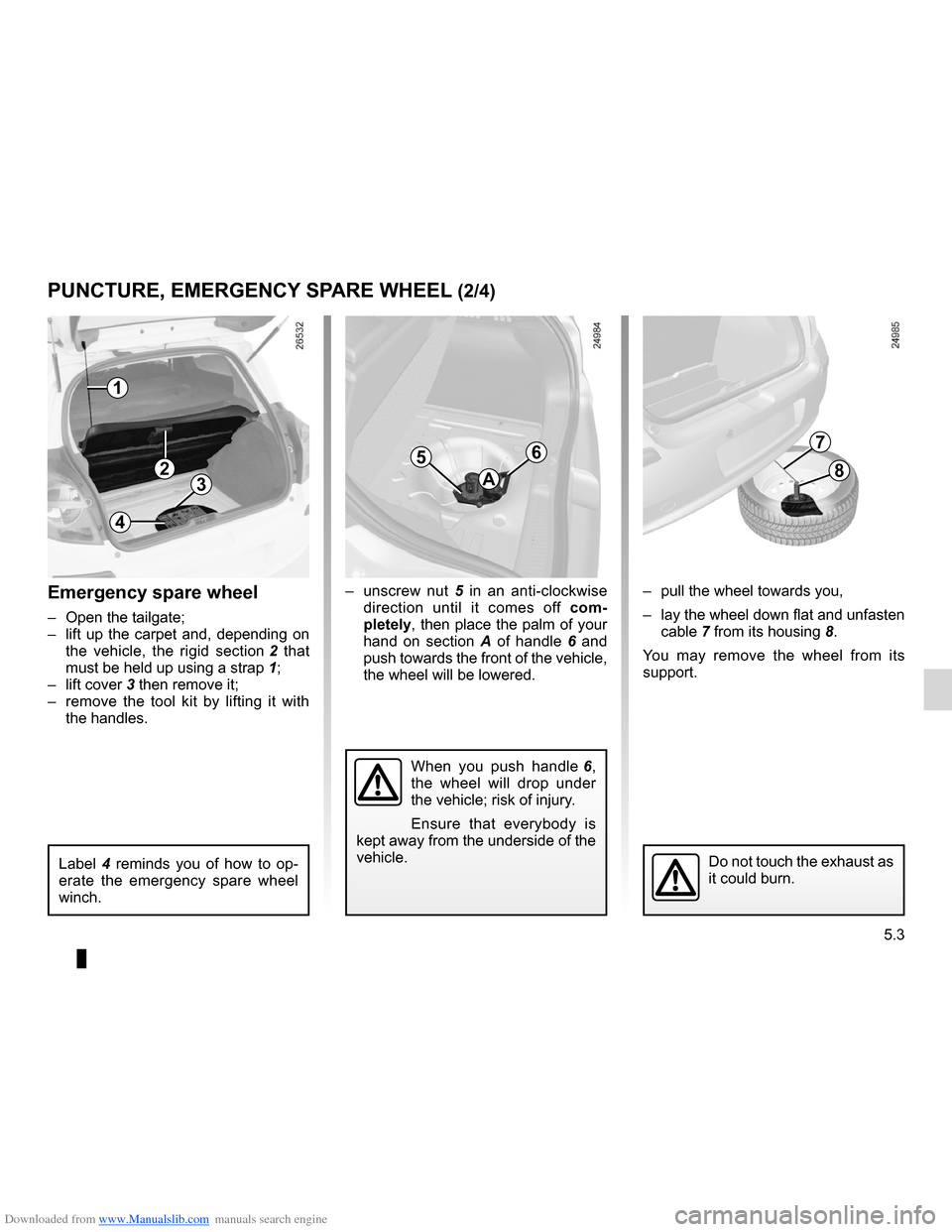
Downloaded from www.Manualslib.com manuals search engine JauneNoirNoir texte
5.3
ENG_UD24923_2
Roue de secours (X85 - B85 - C85 - S85 - K85 - Renault)
ENG_NU_853-7_BCSK85_Renault_5
1
23
4
Emergency spare wheel
– Open the tailgate;
– lift up the carpet and, depending on
the vehicle, the rigid section 2 that
must be held up using a strap 1;
– lift cover 3 then remove it;
– remove the tool kit by lifting it with
the handles.
Label 4 reminds you of how to op -
erate the emergency spare wheel
winch.
56
A
– unscrew nut 5 in an anti-clockwise
direction until it comes off com-
pletely, then place the palm of your
hand on section A of handle 6 and
push towards the front of the vehicle,
the wheel will be lowered.
When you push handle 6 ,
the wheel will drop under
the vehicle; risk of injury.
Ensure that everybody is
kept away from the underside of the
vehicle.
7
8
– pull the wheel towards you,
– lay the wheel down flat and unfasten
cable 7 from its housing 8.
You may remove the wheel from its
support.
Do not touch the exhaust as
it could burn.
PUNCTURE, EMERGENCY SPARE WHEEL (2/4)
Page 197 of 268
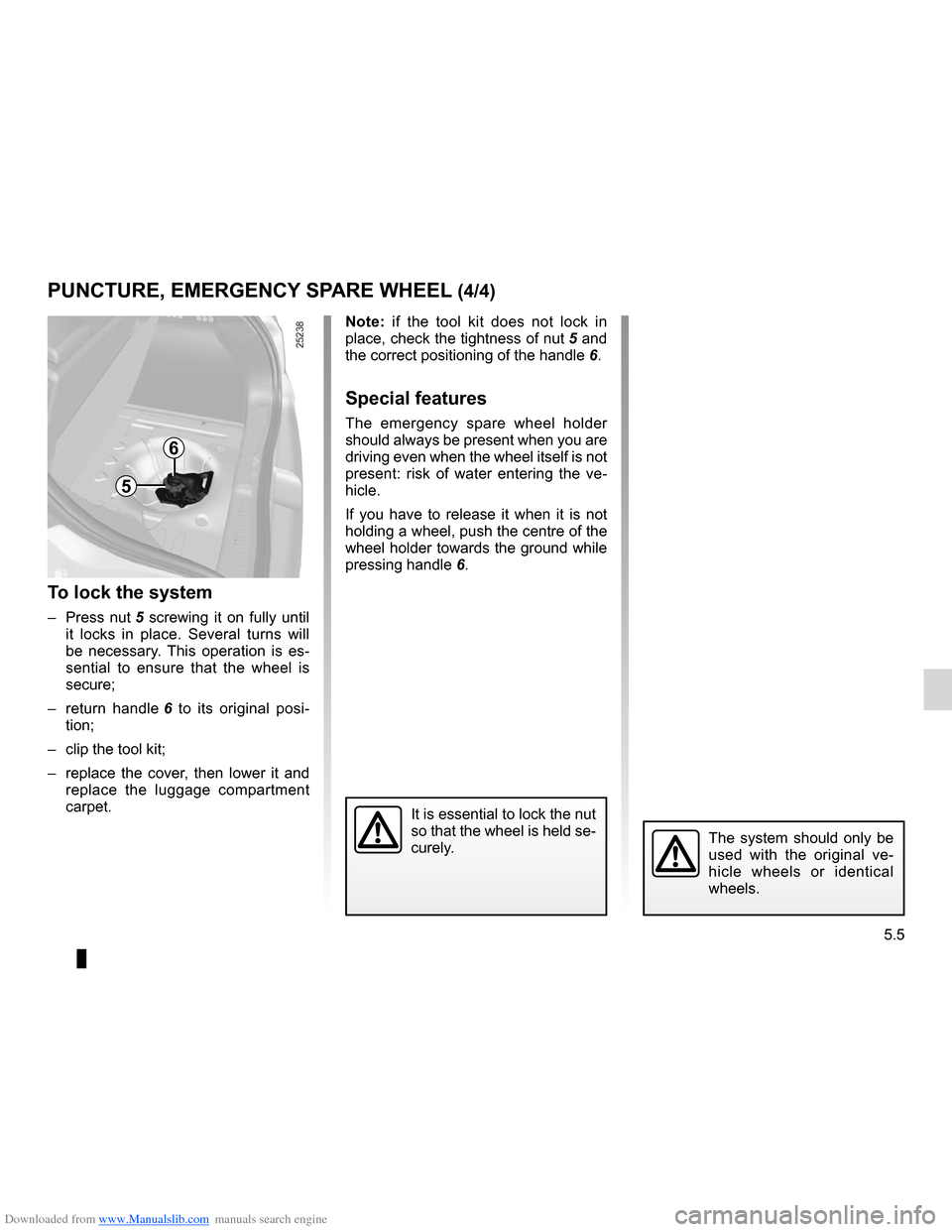
Downloaded from www.Manualslib.com manuals search engine JauneNoirNoir texte
5.5
ENG_UD24923_2
Roue de secours (X85 - B85 - C85 - S85 - K85 - Renault)
ENG_NU_853-7_BCSK85_Renault_5
Note: if the tool kit does not lock in
place, check the tightness of nut 5 and
the correct positioning of the handle 6.
Special features
The emergency spare wheel holder
should always be present when you are
driving even when the wheel itself is not
present: risk of water entering the ve -
hicle.
If you have to release it when it is not
holding a wheel, push the centre of the
wheel holder towards the ground while
pressing handle 6.
To lock the system
– Press nut 5 screwing it on fully until
it locks in place. Several turns will
be necessary. This operation is es -
sential to ensure that the wheel is
secure;
– return handle 6 to its original posi -
tion;
– clip the tool kit;
– replace the cover, then lower it and
replace the luggage compartment
carpet.
PUNCTURE, EMERGENCY SPARE WHEEL (4/4)
The system should only be
used with the original ve -
hicle wheels or identical
wheels.
It is essential to lock the nut
so that the wheel is held se-
curely.
6
5
Page 201 of 268

Downloaded from www.Manualslib.com manuals search engine tool kit ................................................... (up to the end of the DU)
hubcap tool ........................................... (up to the end of the DU)
jack ....................................................... (up to the end of the DU)
wheelbrace ........................................... (up to the end of the DU)
towing hitch ........................................... (up to the end of the DU)
wheelbrace ........................................... (up to the end of the DU)
puncture ................................................ (up to the end of the DU)
5.9
ENG_UD19792_3
Bloc-outils (X85 - B85 - C85 - S85 - K85 - Renault)
ENG_NU_853-7_BCSK85_Renault_5
End piece for special wheel
bolt 3
Towing hitch 4
Refer to the information on “Towing” in
Section 5.
Hubcap tool 5 or 6This tool is used to remove the wheel
trims.
Jack 7Remove jack 7.
To refit, lower the jack fully and unscrew
it by one turn and pivot the base so that
it can be stored.
Storage compartment 1(depending on vehicle)
This is for storing a lock nut.
Wheelbrace 2This is used to tighten or release the
wheel bolts.
The tools included in the tool kit depend
on the vehicle.
Tool kit
A is located in the tray under
the luggage compartment carpet.
Depending on the vehicle, lift the cover,
then remove it.
Take out the tool kit, lifting it at both
ends.
To return it, proceed in the reverse
order to removal.
TOOL KIT
Tool kit
1
A
7
2
3
4
56
Do not leave the tools unsecured inside the vehicle as they may come loose under braking. After use, check that all the
tools are correctly clipped into the tool kit, then position it correctl\
y in its housing: there is a risk of injury.
If wheel bolts are supplied in the tool kit, only use these bolts for the emergency spare wheel: refer to the label affixed
to the emergency spare wheel.
The jack is designed for wheel changing purposes only. Under no circumstances should it be used for carrying out repairs un-
derneath the vehicle or to gain access to the underside of the vehicle.
Page 212 of 268
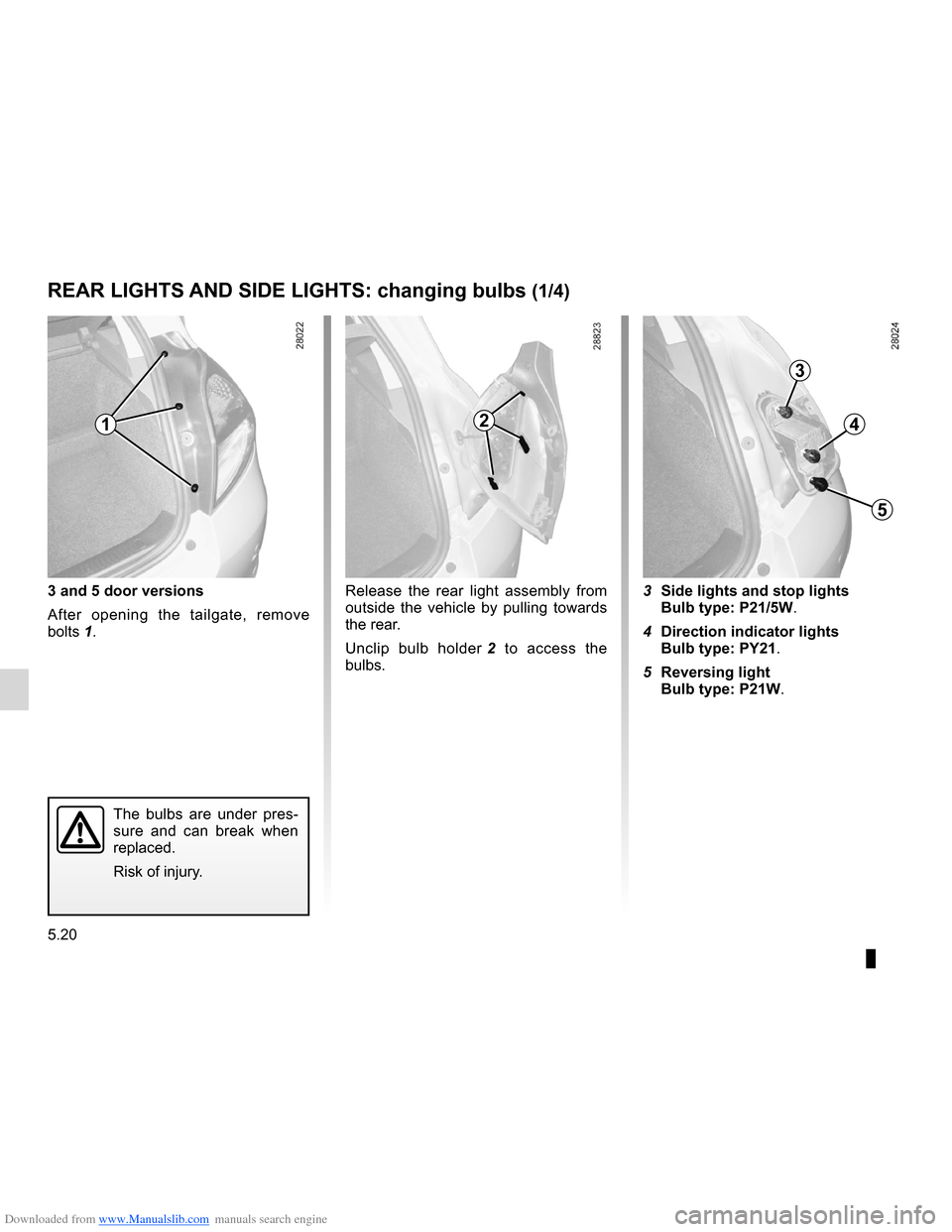
Downloaded from www.Manualslib.com manuals search engine bulbschanging ......................................... (up to the end of the DU)
changing a bulb .................................... (up to the end of the DU)
indicators .............................................. (up to the end of the DU)
lights: fog lights .......................................................... (current page)
lights: direction indicators ........................................... (current page)
lights: side lights ......................................................... (current page)
lights: reversing lights ................................................. (current page)
lights: brake lights ..................................... (up to the end of the DU)
bulbs changing ......................................... (up to the end of the DU)
5.20
ENG_UD16854_3
Feux arrière : remplacement des lampes (X85 - B85 - C85 - S85 - K85 \
- Renault)
ENG_NU_853-7_BCSK85_Renault_5
Jaune NoirNoir texte
Release the rear light assembly from
outside the vehicle by pulling towards
the rear.
Unclip bulb holder 2 to access the
bulbs.
Rear lights and side lights (changing bulbs)
The bulbs are under pres -
sure and can break when
replaced.
Risk of injury.
3 Side lights and stop lights
Bulb type: P21/5W.
4 Direction indicator lights
Bulb type: PY21.
5 Reversing light
Bulb type: P21W.
3 and 5 door versions
After opening the tailgate, remove
bolts 1.
REAR LIGHTS AND SIDE LIGHTS:
changing bulbs (1/4)
3
4
5
12
Page 213 of 268

Downloaded from www.Manualslib.com manuals search engine JauneNoirNoir texte
5.21
ENG_UD16854_3
Feux arrière : remplacement des lampes (X85 - B85 - C85 - S85 - K85 \
- Renault)
ENG_NU_853-7_BCSK85_Renault_5
Sport tourer Versions
After opening the tailgate, unscrew
bolts 1.
REAR LIGHTS AND SIDE LIGHTS: changing bulbs (2/4)
3 Direction indicator lights
Bulb type: P21W.
4 Side light and brake light
Bulb type: P21/5W.
5 Reversing light
Bulb type: P21W.
Release the rear light assembly from
outside the vehicle by pulling towards
the rear.
Remove the clips 2 from the bulb holder
to access the bulbs.
1
2
43
5
Page 222 of 268
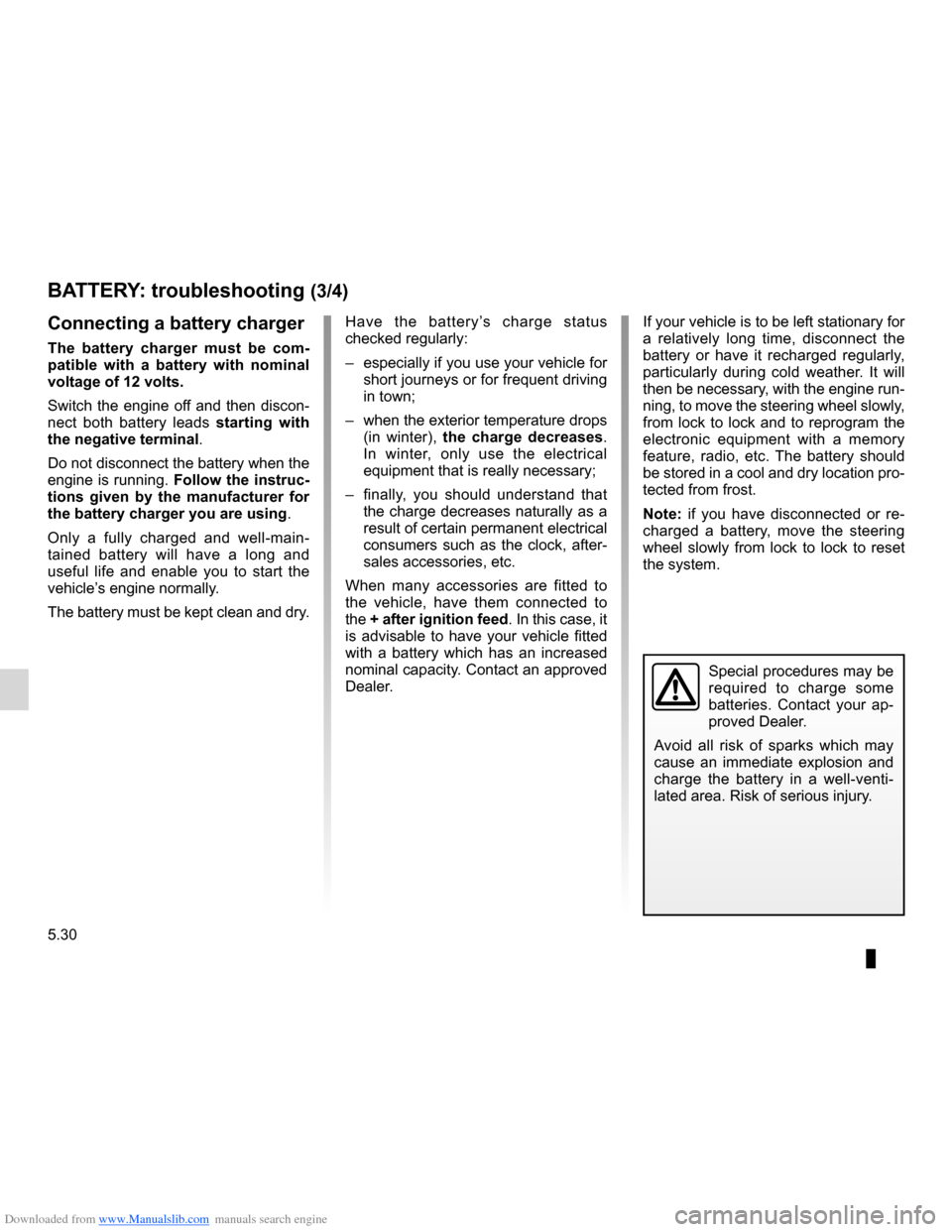
Downloaded from www.Manualslib.com manuals search engine 5.30
ENG_UD12592_2
Batterie : dépannage (X85 - B85 - C85 - S85 - K85 - Renault)
ENG_NU_853-7_BCSK85_Renault_5
Jaune NoirNoir texte
BATTERY: troubleshooting (3/4)
Special procedures may be
required to charge some
batteries. Contact your ap-
proved Dealer.
Avoid all risk of sparks which may
cause an immediate explosion and
charge the battery in a well-venti -
lated area. Risk of serious injury.
If your vehicle is to be left stationary for
a relatively long time, disconnect the
battery or have it recharged regularly,
particularly during cold weather. It will
then be necessary, with the engine run-
ning, to move the steering wheel slowly,
from lock to lock and to reprogram the
electronic equipment with a memory
feature, radio, etc. The battery should
be stored in a cool and dry location pro-
tected from frost.
Note: if you have disconnected or re -
charged a battery, move the steering
wheel slowly from lock to lock to reset
the system.
Have the battery’s charge status
checked regularly:
–
especially if you use your vehicle for
short journeys or for frequent driving
in town;
– when the exterior temperature drops
(in winter), the charge decreases .
In winter, only use the electrical
equipment that is really necessary;
– finally, you should understand that
the charge decreases naturally as a
result of certain permanent electrical
consumers such as the clock, after-
sales accessories, etc.
When many accessories are fitted to
the vehicle, have them connected to
the + after ignition feed. In this case, it
is advisable to have your vehicle fitted
with a battery which has an increased
nominal capacity. Contact an approved
Dealer.Connecting a battery charger
The battery charger must be com -
patible with a battery with nominal
voltage of 12 volts.
Switch the engine off and then discon -
nect both battery leads starting with
the negative terminal.
Do not disconnect the battery when the
engine is running. Follow the instruc-
tions given by the manufacturer for
the battery charger you are using.
Only a fully charged and well-main -
tained battery will have a long and
useful life and enable you to start the
vehicle’s engine normally.
The battery must be kept clean and dry.
Page 230 of 268
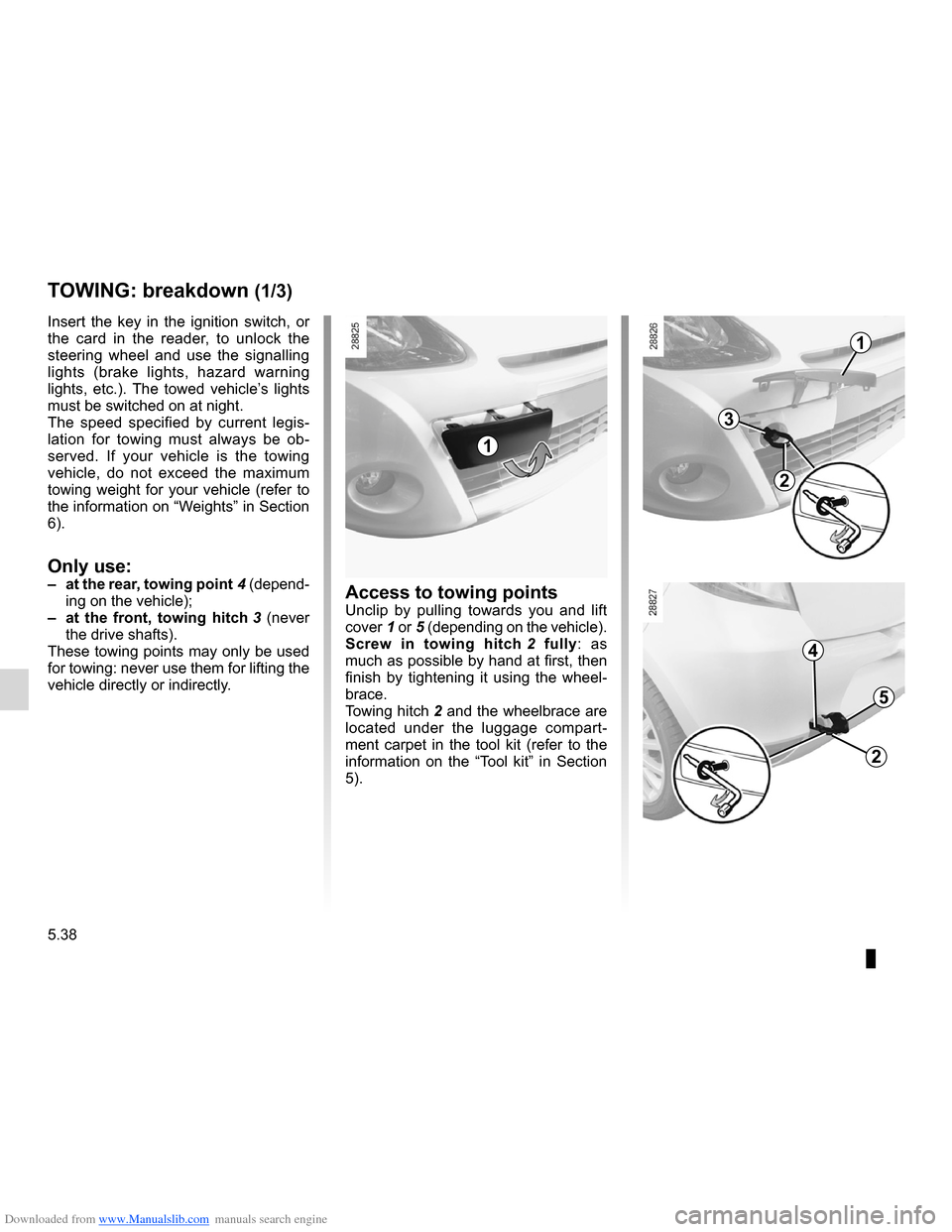
Downloaded from www.Manualslib.com manuals search engine towing hitch........................................... (up to the end of the DU)
towing breakdown ...................................... (up to the end of the DU)
5.38
ENG_UD16944_3
Remorquage : dépannage (X85 - B85 - C85 - S85 - K85 - Renault)
ENG_NU_853-7_BCSK85_Renault_5
Jaune NoirNoir texte
Insert the key in the ignition switch, or
the card in the reader, to unlock the
steering wheel and use the signalling
lights (brake lights, hazard warning
lights, etc.). The towed vehicle’s lights
must be switched on at night.
The speed specified by current legis -
lation for towing must always be ob -
served. If your vehicle is the towing
vehicle, do not exceed the maximum
towing weight for your vehicle (refer to
the information on “Weights” in Section
6).
Only use:– at the rear, towing point 4 (depend-
ing on the vehicle);
– at the front, towing hitch 3 (never
the drive shafts).
These towing points may only be used
for towing: never use them for lifting the
vehicle directly or indirectly.Access to towing pointsUnclip by pulling towards you and lift
cover 1 or 5 (depending on the vehicle).
Screw in towing hitch 2 fully : as
much as possible by hand at first, then
finish by tightening it using the wheel -
brace.
Towing hitch 2 and the wheelbrace are
located under the luggage compart -
ment carpet in the tool kit (refer to the
information on the “Tool kit” in Section
5).
Towing
TOWING: breakdown (1/3)
3
1
2
1
5
2
4
1
Page 231 of 268

Downloaded from www.Manualslib.com manuals search engine JauneNoirNoir texte
5.39
ENG_UD16944_3
Remorquage : dépannage (X85 - B85 - C85 - S85 - K85 - Renault)
ENG_NU_853-7_BCSK85_Renault_5
Towing a vehicle with an
automatic gearbox
With the engine switched off: the
transmission is no longer lubricated. It
is preferable to tow this type of vehi -
cle on a trailer or tow it with the front
wheels off the ground.
Under exceptional circumstances,
you may tow the vehicle with all four
wheels on the ground, only going
forward, with the gear lever in the
Neutral position, and for a distance
not exceeding 30 miles (50 km).
If the lever is stuck in P,
even though you are de -
pressing the brake pedal,
the lever can be released
manually.
To do this, unclip the upper section
of the cover at the base of the lever.
Press simultaneously on the mark
on the gaiter and the unlocking
button on the lever.
– Use a rigid towing bar.
If a rope or cable is used
(where the law allows this),
the vehicle being towed
must be able to brake.
– A vehicle must not be towed if it is
not fit to be driven.
– Avoid accelerating or braking
suddenly when towing, as this
may result in damage being
caused to the vehicle.
– When towing a vehicle, it is ad -
visable not to exceed 15 mph (25
km/h).
– Do not push the vehicle if the
steering column is locked.
Towing procedure
Before any towing, check that the steer-
ing column is not locked.
If it is locked, insert the RENAULT card
into the reader and press the Start/Stop
button for five seconds without press-
ing on the pedals. The steering column
unlocks and the vehicle accessories
functions are supplied.
Leave the card in the reader while
towing.
Press the Start/Stop button twice in
succession once towing is finished (risk
of running down the battery).
TOWING: breakdown (2/3)
Do not leave the tools unse-
cured inside the vehicle as
they may come loose under
braking.
W h e n t h e e n g i n e i s
stopped, steering and brak-
ing assistance are not op -
erational.
Do not remove the key from
the ignition switch or the
card from the reader during
towing.
Page 232 of 268

Downloaded from www.Manualslib.com manuals search engine towingtowing a caravan .............................................. (current page)
towing towing equipment ............................................. (current page)
towing equipment fitting ................................................................ (current page)
5.40
ENG_UD16944_3
Remorquage : dépannage (X85 - B85 - C85 - S85 - K85 - Renault)
ENG_NU_853-7_BCSK85_Renault_5
Towing a vehicle with a
Quickshift gearbox
If a gear is engaged:
– with the ignition on, select neutral
while depressing the brake pedal;
– check that neutral is engaged (e.g.
by pushing the vehicle);
– switch off the ignition.
The vehicle should always be towed
with the ignition switched off.
If you cannot engage neutral, the vehi-
cle must be towed with its front wheels
off the ground.
Permissible nose weight, maxi -
mum permissible towing weight,
braked and unbraked: refer to
the information on “Weights” in
Section 6.
For fitting and conditions of use,
refer to the equipment’s fitting in -
structions.
Please keep these instructions with
the rest of the vehicle documenta -
tion.
TOWING: breakdown (3/3)/ATTACHMENTS
A
A: 681 mm (3 or 5 door versions)
A: 901 mm (sport tourer version)
Page 241 of 268
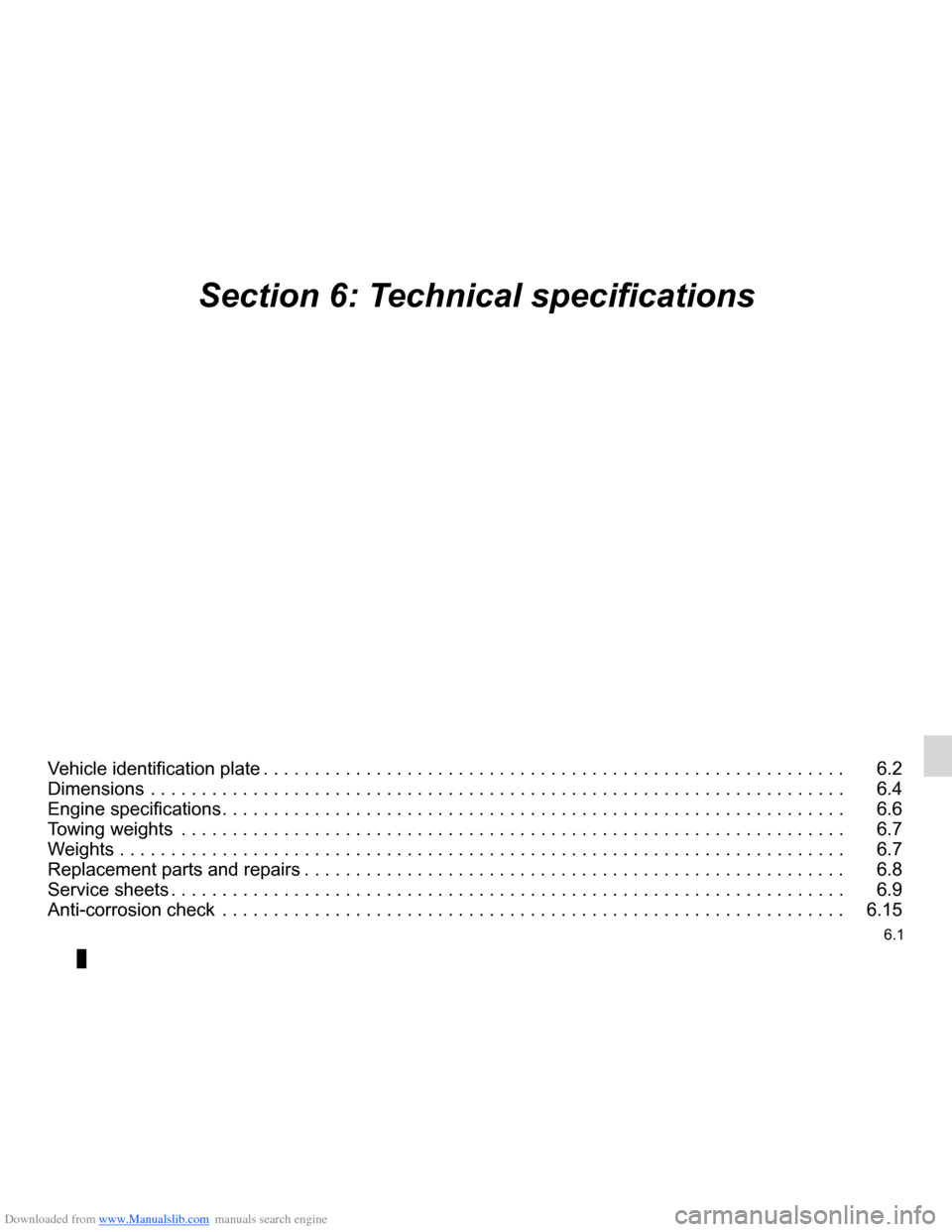
Downloaded from www.Manualslib.com manuals search engine 6.1
ENG_UD25612_8
Sommaire 6 (X85 - B85 - C85 - S85 - K85 - Renault)
ENG_NU_853-7_BCSK85_Renault_6
Section 6: Technical specifications
Vehicle identification plate . . . . . . . . . . . . . . . . . . . . . . . . . . . . . . . . . . . . . . . . . . . . . . . . . . . . . . . . . 6.2
Dimensions . . . . . . . . . . . . . . . . . . . . . . . . . . . . . . . . . . . . . . . . . . . . . . . . . . . . . . . . . . . . . . . . . . . . 6.4
Engine specifications . . . . . . . . . . . . . . . . . . . . . . . . . . . . . . . . . . . . . . . . . . . . . . . . . . . . . . . . . . . . . 6.6
Towing weights . . . . . . . . . . . . . . . . . . . . . . . . . . . . . . . . . . . . . . . . . . . . . . . . . . . . . . . . . . . . . . . . . 6.7
Weights . . . . . . . . . . . . . . . . . . . . . . . . . . . . . . . . . . . . . . . . . . . . . . . . . . . . . . . . . . . . . . . . . . . . . . . 6.7
Replacement parts and repairs . . . . . . . . . . . . . . . . . . . . . . . . . . . . . . . . . . . . . . . . . . . . . . . . . . . . . 6.8
Service sheets . . . . . . . . . . . . . . . . . . . . . . . . . . . . . . . . . . . . . . . . . . . . . . . . . . . . . . . . . . . . . . . . . . 6.9
Anti-corrosion check . . . . . . . . . . . . . . . . . . . . . . . . . . . . . . . . . . . . . . . . . . . . . . . . . . . . . . . . . . . . . 6.15